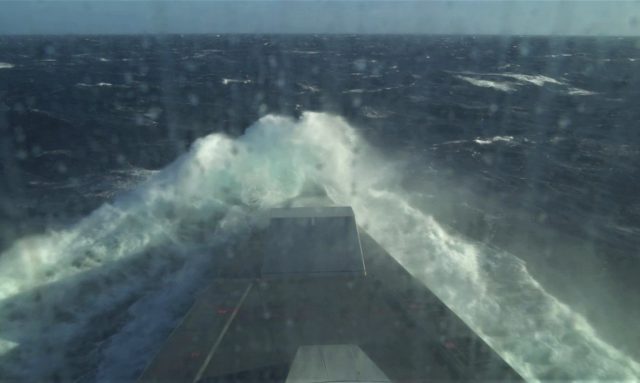The US Navy’s “super-stealth” Zumwalt-class destroyer has completed rough water sea trials in Sea State 6, which features waves 4 to 6 meters high.
The navy said the final phase of the destroyer’s rough water trials took place in two storms near San Francisco and near Ketchikan, Alaska. The storm-driven conditions exceeded expectations in terms of exposure time and wave steepness and enabled the team to satisfy all objectives of the testing.
With the successful completion of the trials, the three strong destroyer class is dispelling worries about the ships’ wave-piercing tumblehome design, which some said would be troublesome in rough sea.
“The trial evaluated the seakeeping and structural response of DDG 1000 and was conducted under the Performance and Special Trials (P&ST) program, which is a collection of tests to develop class-baseline hydrodynamic, structural and machinery performance information,” a Naval Sea Systems release said.
Separated into two phases, the first phase of the rough-water trials was performed in October 2019. The team evaluated the seakeeping behavior, structural response and operability of DDG 1000 in mission-relevant conditions in Sea States 3, 4 and 5. This assessment also evaluated how the ship motion conditions affect crew performance.
Unlike the calm-water trials, which were conducted near San Clemente Island close to the ship’s homeport of San Diego, California, the rough-water trials required conditions that were not benign. The rough-water trials director, Stephen Minnich, explained why his team chose to move further north for the second phase of trials, citing a good rule of thumb: storm intensity tends to increase the further north you go in the Eastern Pacific. Wave climatology studies informed the selection of test locations and schedule to increase the likelihood of finding the required wave conditions. The team used a variety of wave forecasting models to guide the actual execution of testing.
“We chose locations and times to conduct the testing that would correspond with what forecast models were indicating would provide the wave conditions required to complete our test matrix,” Minnich said. “We deployed wave buoys that drifted on the sea surface, which helped us to quantify the seaway in terms of the wave height, period, and direction. We were completely at the mercy of Mother Nature during the testing, but those devices were critically important to the characterization of what we were seeing in terms of ship motion and structural response and for the situational awareness they provided to support safe execution of the testing.”
Minnich and his team were encouraged by the results of the rough-water trials, noting that there were no exceedances of critical motion criteria limits.
Next on the agenda for the trial team will be to replicate the conditions of the second phase of Rough-Water Trials at model scale in the test facilities at Carderock. This includes reproducing the wave environments and the ship loading conditions for a Seakeeping Correlation test. The model test will take place in Carderock’s Maneuvering and Seakeeping Basin beginning in late March 2021.
“Effectively, we will be re-running critical portions of the trial at model scale onsite at Carderock,” Minnich said. “This will enable us to quantify the differences between our model-scale predictions and our full-scale observations.”



























